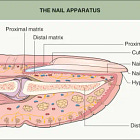Structure of the fingernail

What is it? The fingernails are hard, protective structures at the ends of mammalian fingers, including in humans. They are made of alpha-keratin, a polymer similar to horn or hoof in other mammals.
Each fingernail has several parts:
Nail bed - the skin under the nail where blood vessels and nerves are
Nail root - where the nail matrix (also called germinal matrix) generates cells that become the nail plate, the visible part under the nail is the lunula
Nail plate - what we know as the fingernail, the size and shape are determined by the underlying fingerbone - the free margin is the cutting edge of the nail
Hyponychium - the epithelium at the open edge of the nail plate (also known as the quick)
Eponychium and cuticle - the cuticle is dead skin that seals the the base of the nail to the skin, and it is produced by the eponychium (or proximal nail fold)
Paronychium - the skin folds around the edges of the nail plate (or lateral nail fold)

Gross fact: infection around the edge of the nail is called paronychia
For more information:
Cleveland Clinic - paronychia
Encyclopedia Britannica - nail
ResearchGate - alpha-keratin



